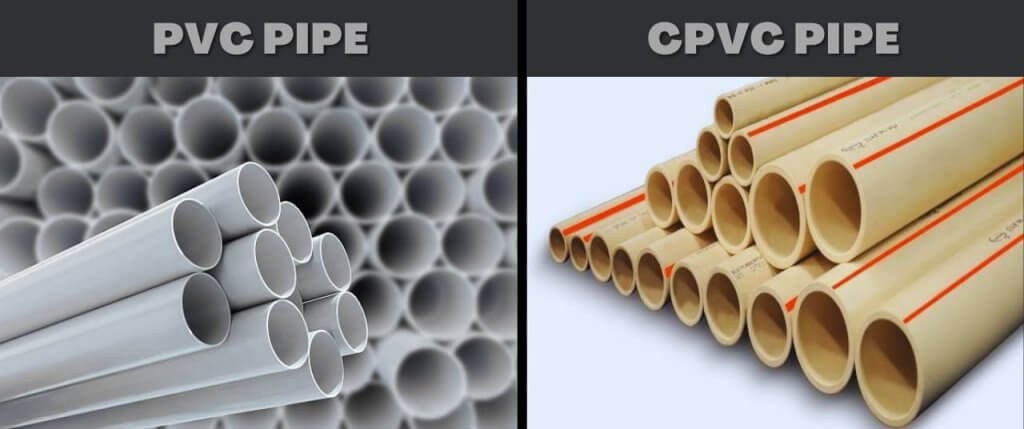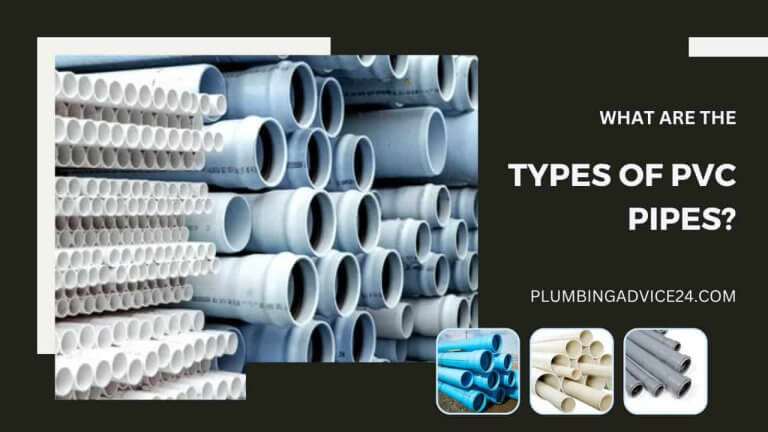Difference Between PVC and CPVC
Although PVC and CPVC are both plastic materials, they have different characteristics, construction, and limitations. In this article, we will see the difference between PVC and CPVC. In addition, we are also going to discuss the things that you should keep in mind while choosing one of the two materials, so I hope this article will be very useful for you.
When PVC became popular in the 1950s, PVC had many advantages but also some limitations. Due to this, the need arose to remove its limitation. CPVC was invented 9-10 years later in 1960 to meet the limitations of PVC, which proved superior to PVC for hot and cold potable water domestic piping and commercial piping systems. This new modified version of PVC, called CPVC, is a more stable polymer and can withstand higher temperatures than standard PVC.
Generally, PVC contains 56-57% chlorine, while the chlorine content increases after the chlorination of PVC, and CPVC has 63-67% chlorine in its hydrocarbon chain. This introduction of chlorine makes the polymer a very stable polymer and provides high-temperature stability. This also reduces the oxidation capacity of the polymer, which is the main cause of degradation of the polymer on exposure to UV radiation, heat, and oxygen.
What Is the Difference Between PVC and CPVC Pipe?
PVC and CPVC pipes are plastic pipes, but their colors can identify them. PVC pipes are usually white or gray in color, while CPVC pipes are off-white, light gray, or yellow in color. The main difference between PVC and CPVC pipes is the temperature range. PVC can handle temperatures up to 140° Fahrenheit, while CPVC can handle temperatures up to 200° Fahrenheit. Above that temperature, both pipe materials will begin to soften.
Difference in Composition
The biggest difference between PVC pipe and CPVC pipe is not at all visible from the outside but exists at the molecular level. CPVC is made by adding chlorinated to PVC. This chlorination process itself changes the chemical makeup and use of plastic. Although both are more affordable than alternatives like steel or copper, CPVC costs much more.
Variations in Pipe Strength
Chlorine added to CPVC increases its heat tolerance; it also changes the strength of the material. Both Pipe materials are very strong, but CPVC is harder and more brittle than PVC, which makes it more prone to breakage and can be deformed or cracked more easily. If you are using long lengths of CPVC, you will need to add supports every 3 feet.
Physical Appearance
The color of PVC pipe is traditionally white or dark gray (Both of which are sized with reference to the same NPS standard sizing.) While CPVC pipes are found in two colors – light gray (refers to the inner bore diameter of the NPS pipe) and light yellow (copper tube size, which refers to the outside diameter of the CTS tube). Both types of plastic pipes will have their specifications printed on the side.
PVC pipes are available in two forms. A rigid form (also known as uPVC) and a flexible form (plasticized PVC, simply known as PVC). While CPVC pipe is found in a rigid form.
Range of Temperature Tolerance
One disadvantage of using PVC and CPVC for water applications is that PVC can only handle temperatures up to 140° Fahrenheit. Anything hotter than 140 degrees will melt. To give you context, the maximum temperature of a hot-water heater is usually between 120°-140° Fahrenheit. Therefore, PVC cannot be considered a truly safe material in indoor plumbing.
Whereas CPVC can handle temperatures up to 200° Fahrenheit, which is a 60-degree rise. Although this is still not the highest water-temperature tolerance in plumbing, it is significantly better than PVC.
Installation Process
CPVC and PVC pipes are similar in many ways, but they should not be used interchangeably. Both are made up of the same basic elements with a distinctive factor. CPVC is replaced by a free radical chlorination reaction that effectively increases the chlorine content of the material. CPVC is also a thermoplastic that is molded into the same products as PVC.
Due to differences in the chemical composition of PVC and CPVC materials, both have different primers, solvent cement, and bonding agents. PVC solvent cement meets ASTM D2564 specifications, while CPVC solvent cement meets ASTM F493 specifications.
Because of this, Both plumbing pipes and fittings, along with their solvents and bonding agents, cannot be used interchangeably. In addition to meeting ASTM specifications, different solvent cement is required depending on pipe size and intended application, so make sure you’re using the right agent for the right application.
Difference in Price
CPVC is made by adding chlorinated to PVC. The addition of chlorine in the manufacturing process makes CVPC pipes more expensive. Their exact price, as well as quality, depends on the particular manufacturer. Although both are more affordable than alternatives like steel or copper, the CPVC pipe price is much higher.
CPVC is a more expensive product, so it is generally the material of choice for hot water applications, while PVC is used for cold water applications such as irrigation and drainage. So, if you are considering PVC or CPVC for your next project, temperature and cost are two important factors to consider.
Must Read : Types of PVC Pipe | What Is the Difference Between Schedule 40 and Schedule 80
Are PVC and CPVC Interchangeable?
CPVC is better suited for hot water applications around 200F. PVC is still commonly used for unheated water along vent and drainage systems; However, CPVC is actually widely used for both hot and cold potable water.
The more resistant properties of CPVC make it beneficial for industrial and industrial applications. Due to the wide variety of applications, CPVC is generally more expensive than PVC. That being said, it is still a very cost-efficient and flexible material.
You can use PVC for cold water systems, vent systems, and drain systems in your home or building. However, CPVC should be used for applications where the maximum temperature will exceed 140 degrees Fahrenheit, although CPVC’s maximum rating remains under 200 degrees Fahrenheit.
Another determining factor in which material to use is the chemical makeup of the media in your application. Both materials are resistant to many of the same chemicals; some are best handled by one or the other. Before installing CPVC or PVC pipe, you should decide what project you are choosing the pipe for.
Must Read : Difference Between ABS and PVC | How to Connect ABS to PVC Pipe | Which is Better ABS or PVC Pipe
Can You Attach PVC to CPVC Pipe?
All NPS sizes of pipe and fittings will fit together, but it is not recommended that you mix and match materials. Mixing materials can compromise the temperature and pressure ratings of the pipeline. For this reason, professionals always recommend that any pressurized pipe system be constructed using matching piping materials and schedules.
Must Read : Types of Metal Pipes | Seamless vs. Welded Steel Pipe And Their Manufacturing Process
Which Is Better PVC or CPVC Pipe?
Deciding between PVC and CPVC pipes depends on the specific needs of each project, which is why it’s so important to consider the capabilities and limitations of each material. Because they perform very similar functions, you should decide what project you want to use the pipe for before choosing one.
If the pipes are to be exposed to any kind of heat, it is safer to use CPVC as it has a higher resistance to heat. In some cases paying a higher price for CPVC does not provide any additional benefits.
As such, PVC is recommended for cold water systems, vent systems, drainage systems, and irrigation systems. Since CPVC is more expensive and doesn’t offer anything extra, PVC would be the best choice for this project.
For your convenience in choosing between PVC and CPVC pipes, we have provided a table below, through which you will be able to make a clear decision knowing the characteristics, capabilities, and limitations of both Pipes.
| Characteristic | PVC PIPE | CPVC PIPE |
| Colour | white, dark grey | light grey, off-white, yellow |
| Cost | $0.40 – $0.52 / ft. | $2.50 – $3.02 / ft. |
| End Shape | plain, bell | plain |
| Working Max Pressure | 450 – 630 PSI | 450 – 630 PSI |
| Tensile Strength | 7500 PSI | 8200 PSI |
| Standard Length | 1O’, 20′ | 10′ |
| Sizing | NPS | NPS, CTS |
| Max Temp | 140° F | 200° F |
| Min Temp | 33° F | 33° F |
Must Read : Types of Steel Pipes | Stainless Steel Pipe Vs. Carbon Steel Pipe | Both Steel Pipes Applications
What Is the Difference Between PVC and CPVC?
Although both PVC and CPVC are plastic pipe materials, they differ in many ways. Differences in their composition, variation in pipe strength, physical appearance, range of temperature tolerance, and installation process are key factors that distinguish the two from each other.
Is CPVC Stronger Than PVC?
Both materials are very strong, but CPVC is harder than PVC, which makes it more prone to breaking. CPVC is more brittle than PVC and can be warped or cracked more easily, but it is also more flexible than PVC. If you’re using long lengths of CPVC, you’ll need to add support every 3 feet.
Is CPVC the Same As PVC?
The main difference between both pipe materials is the range of temperatures each is capable of withstanding. CPVC is better suited for hot water applications around 200F. PVC is still commonly used for unheated water along vent and drainage systems; However, CPVC is actually widely used for both hot and cold potable water.
Is CPVC Better Than PVC?
If the pipes are to be exposed to any kind of heat, it is safer to use CPVC as it has a higher resistance to heat. As such, PVC is recommended for cold water systems, vent systems, drainage systems, and irrigation systems. Since CPVC is more expensive and doesn’t offer anything extra, PVC would be the best choice for this project.
Are PVC and CPVC the Same Size?
The color of PVC pipe is traditionally white or dark gray (Both of which are sized with reference to the same NPS standard sizing.) While CPVC pipes are found in two colors – light gray (refers to the inner bore diameter of the NPS pipe) and light yellow (copper tube size, which refers to the outside diameter of the CTS tube). Both types of plastic pipes will have their specifications printed on the side.
What Happens If I Use PVC Glue on CPVC?
CPVC is a stronger version of PVC pipe with a higher melting point and tougher chemical structure. This means old-fashioned PVC cement will not be fully effective on CPVC. For this reason, you cannot use just any PVC cement to join these two materials together.
Can CPVC Be Used Outdoors?
CPVC maintains its mechanical strength outdoors. This is particularly useful for designers who want to use more variety of colors without compromising on performance. CPVC can be used anywhere the natural and man-made corrosive elements of the outdoors traditionally cause degradation in materials.
If You Liked This Post? So Share It with Your Friends
Suggested Articles:
- What Is Plumbing Pipe Materials | What Is Used to Make Plumbing Pipes
- What Type of Piping Is Used in Homes | Types of Pipes for Water Supply
What Is a Sewer Line | How Many Types of Sewer Pipes | Best Sewer Line Insurance Company
What Is Plumbing Pipe | 22 Different Types of Plumbing pipes
- Five Easy Steps to Repair PVC Pipe | How to Replace PVC Pipe











